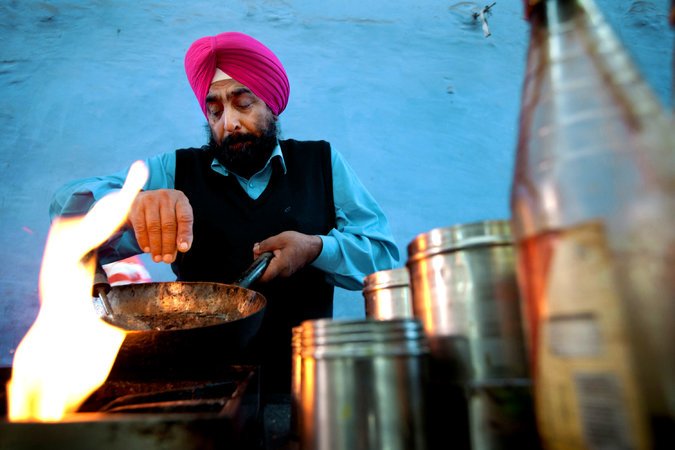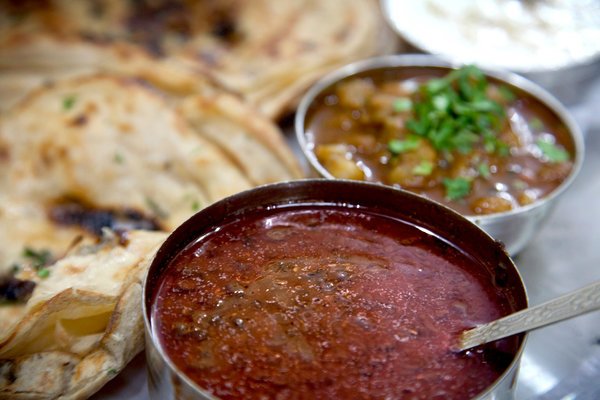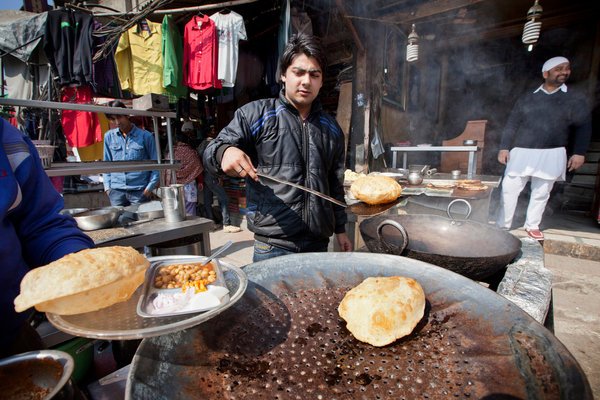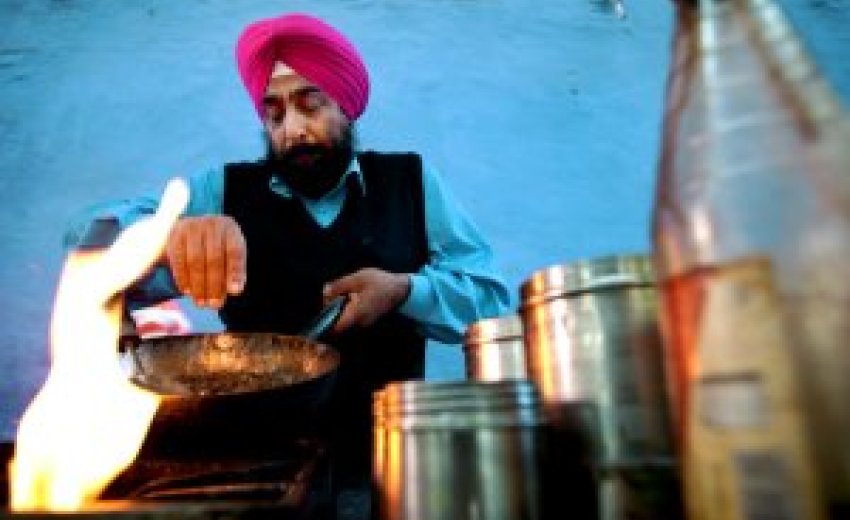 |
| Cooking at Surjit Food Plaza in Amritsar, India. Credit Kuni Takahashi for The New York Times |
MARCH 18, 2014: Within five minutes of ordering three deluxe thalis at the large and bustling Bharawan da Dhaba in Amritsar, India, a waiter brought us round steel trays filled with our $3 lunch. There were a half-dozen bowls on each, which included spicy chickpeas with a hint of pomegranate powder, the black lentils known as daal and the Punjabi comfort food equivalents of macaroni and cheese — the creamy mustard greens called sarso ka saag and kadhi, a yellow chickpea flour and yogurt curry swimming with fried onion fritters. Lachedar parantha, whole wheat butter-layered bread, fresh from the tandoor clay oven, was our accompaniment.
These were the same dishes that Bharawan, a casual restaurant known as a dhaba, first served when it opened in 1912 as a covered tent restaurant, and they are what keep the crowds coming back more than a hundred years later.
Amritsar in the state of Punjab in northern India is a city for pilgrimages: There are those who come to visit the Golden Temple, the Sikh house of worship built in the 16th century, and then there are the presumably less pious who make the trip for the dhabas — divey looking joints famous for quick, inexpensive and remarkably tasty Punjabi cuisine.
 |
| Daal makhani at Kesar da Dhaba. Credit Kuni Takahashi for The New York Times |
On our mid-December visit, my mother-in-law, Bharati, my sister, Aditi, and I came to pay homage to the latter, and over the course of three days, ate our way through the most notable ones in town.
Many dhabas originated along the highways in Punjab in the mid-20th century to serve hungry truck drivers and eventually started opening in cities throughout the area. The ones in Amritsar, however, were always deemed to be far superior to the rest. As a Punjabi growing up in New Delhi, I heard constant stories from my family over the hearty and often heart-clogging meals characteristic of our sect about the dhaba feasts to be had in Amritsar, and I recently decided to take a trip to taste the supposedly supreme versions of the dishes that are an integral part of my roots.
Although each dhaba has its own specialties, there are similarities: Most of them have been around for a half-century or more and are family-run — actually, make that male-run, often with two or three generations of fathers and sons working together. And they have cultish followings because the dishes are authentic, not inventive, using so much ghee (clarified butter) that even the most traditional French cook would blush.
My primary concern about my ambitious tour was whether my stomach would hold up given the American standards of hygiene I have become accustomed to, having lived in the United States for more than 25 years. But Rashmi Uday Singh, the Mumbai-based food writer who is a judge on the Indian series “The Foodie Show” and who filmed an episode about Amritsar dhabas, eased my fears. “The thing about dhabas is that they usually have no fridges and buy only enough ingredients every morning that they will use in a day so everything is very fresh,” she said.
 |
| Pooris at Kundan. Credit Kuni Takahashi for The New York Times |
It was nostalgia that led me to our first stop: the nearly half-century old Kundan for its legendary chole poori breakfast. Located near the railway station, the small and square strictly vegetarian spot had plastic chairs and tables and dim lighting, but we weren’t there for the ambience. This morning meal of round, deep-fried puffy bread with spicy chickpeas was a beloved weekend tradition at my grandmother’s New Delhi house when I was a child.
A cook standing outside over a large black vat of bubbling oil flattened the dough for our pooris and fried them to a golden finish. Our stainless steel tray held four of them, a generous bowl of chickpeas, another one of cooling yogurt and a side of spicy mango pickle. Our intention was to try just a bit to save room for the abundance of eating ahead, but a few bites of the crispy and chewy bread cradling the tangy and spicy chickpeas wasn’t enough to get our fill. Before long, nearly everything on our 40 rupee platters (less than a $1) rested in our happy stomachs.
With the craving for one classic meal satisfied, it was time to try the most popular Punjabi dish of daal makhani. Apart from chicken tikka masala, these spicy black lentils might be the item most associated with Indian food and a top order for both Indians and non-Indians around the world when they are dining at Indian restaurants.
For this, we headed to Kesar da Dhaba, which we reached by walking through a series of narrow streets in the city center where rickshaws and bicycles were the only vehicles around.
 |
| A dish covered with silver leaf at Kesar da Dhaba. Credit Kuni Takahashi for The New York Times |
When we arrived, we found the owner, Ajay Kumar, 49, chopping cauliflower in the front open kitchen. Behind him were more than a dozen men furiously mincing large bunches of vegetables and cilantro in preparation for the day.
Mr. Kumar’s great-grandfather, Lala Kesar Mul, started Kesar, also a vegetarian restaurant, in 1916. Back then, daal makhani was the prized dish, and nearly a hundred years later, it’s still the reason more than 700 people come here daily.
“We go through 220 pounds of daal a day, and it’s sold out by the evening,” Mr. Kumar said.
Making a batch in the massive steel caldron is a nine-hour endeavor that begins at 4 a.m., when one of Mr. Kumar’s cooks washes and boils lentils until they are soft. Adding salt and red chile powder is next, and a mixture that includes onion, ghee, turmeric and the pungent sweet spice asafetida goes in just before serving. The word makhani means “with butter” in Hindi, and the hot and thick brown daal isn’t complete until it’s scooped into shallow steel bowls and topped with at least a half-stick that gradually melts in and makes for the creamiest rendition we had ever tasted.
By the evening, my sister and I were hankering for a meat fix (my mother-in-law is a vegetarian), which we wisely decided to fulfill with the goat leg curry — a dish we both tried for the first time — at the 50-year-old Pal. The five green tables with cracks running through them and rickety benches in a small room made for a suspect setting, but as we took in the aroma of the curry simmering in a round cast-iron pot in the tiny open kitchen, we forgot about our surroundings.
Jasbir Singh, 40, who runs Pal with his father, Jashpal, says there is a secret to the curry’s deep flavor: roasting and grinding the spices such as garam masala, cumin, coriander and red pepper daily. The chewy and rich goat legs in the soupy gravy beg for naan to scoop it up, but instead of the standard plain variety, Mr. Singh, who does all the cooking at Pal himself, presented us with a version filled with minced mutton. “We are not a place for those who don’t eat meat,” he said.
Because most dhabas are vegetarian, Pal stands out, but rarer still are the ones that sell fish. Fried catfish that is well known in India by different names, including singara, was a household staple for us in Delhi so I was happy to find that it’s the star at two of the most respected dhabas in town, which happen to have a connection. The story began with Makhan Fish & Chicken Corner, which two brothers, Sucha and Sarder Surjit Singh, opened as a stand near the railway station with their father almost 50 years ago. At the time, fish was unheard-of in Amritsar, but they sold fried singara fillets crusted in chickpea flour, caraway seeds and red chile powder. The brothers eventually split, and Sucha kept the Makhan name and opened a two-story dhaba that his son Harjit, 29, now runs and where the original recipe is the reason to dine. The first floor is a place for men to bring in alcohol to enjoy with their heaping platters while families and women with children are relegated to the second floor, an alcohol-free zone. His cousin Amarjit Singh, 33, oversees Surjit Food Plaza, which, with its glass tables, clean white walls and wooden chairs was the most upscale of the dhabas that we visited. Although the same crisp fish is on the menu, Amarjit Singh has distinguished himself with new inventions like the incredibly tender spinach-coated fish kebabs baked in the tandoor, located in the outdoor kitchen in the narrow alley behind the restaurant. There’s also his homemade paneer, an Indian cheese, which my mother-in-law declared was the softest she had ever tried — even softer than hers.
Part of the charm of dhabas is that they function much as they did when they first opened, although they can be savvy about modern marketing. A handful of dhabas, including Surjit, Kesar and Bharawan, have either a Facebook page or a website. Last year, Bharawan’s owner, Subash Vij, 49, even opened an outpost at the food court in the city’s Alpha One mall. “Even in such an old and successful business, change is the law of nature,” he said.
He sat with us while we ate our thalis and saw that we needed more bread to help finish our mustard greens and yellow curry. An oversize leavened flatbread called a kulcha appeared, tempting us with its gentle steam and glistening ghee.
Bharati, Aditi and I eyed one another. Who would have the first bite? Without any discussion, all three of us tore off a piece at once.
